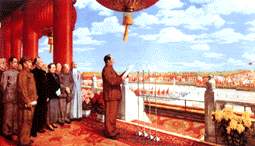 |
| History of China's national flag |

The 1st of October is China's National Day. Fifty-three years ago, at Tian'anmen Square, Chairman Mao Zedong solemnly declared to the world that the People's Republic of China had been established. At that ceremony, the national flag of China made its first appearance and Chinese people sang their national anthem for the first time. Before the ceremony, a committee was set up to solicit designs for the flag and the emblem.
Almost 3,000 different designs for the flag were submitted. In the end, the committee selected the flag design created by Zeng Liansong who wasn't even an artist by trade. He was actually the secretary of the Shanghai Modern Economics Agency.
In Mr. Zeng's design, the flag is entirely bright red except for the five yellow stars (one large star surrounded by four smaller ones) occupying the top left-hand corner. The color red represents the spirit of the revolution, while the five stars represent a united people under the leadership of the Chinese Communist Party.
 On October 1, 1949, Chairman Mao Zedong raised the new flag over Tian'anmen Square. At three o'clock in the afternoon, with 300,000 people watching, Mao Zedong pressed the button on the flagpole, and the national flag with its five stars ascended over Beijing for the first time. After that first momentous flag-raising ceremony, the job was handed over to two workers from the History Museum. The two would come out in the morning, hoist the flag and then take it down in the evening. In the 1960s some discussion started about how to give the flag more of the attention it deserved. In 1969, soldiers with the Beijing garrison took over the task of raising the flag, and after a few years the honor was passed on to a squad of armed police. On October 1, 1949, Chairman Mao Zedong raised the new flag over Tian'anmen Square. At three o'clock in the afternoon, with 300,000 people watching, Mao Zedong pressed the button on the flagpole, and the national flag with its five stars ascended over Beijing for the first time. After that first momentous flag-raising ceremony, the job was handed over to two workers from the History Museum. The two would come out in the morning, hoist the flag and then take it down in the evening. In the 1960s some discussion started about how to give the flag more of the attention it deserved. In 1969, soldiers with the Beijing garrison took over the task of raising the flag, and after a few years the honor was passed on to a squad of armed police.
On December 28, 1982, some new meanings were added to the ceremony. On that morning, 96 honor guards raised the flag in two minutes and seven seconds. That is the same amount of time it takes for the sun to rise above the horizon. The number of 96 also has some symbolic meaning as the territory of China has 9.6 million square kilometers. Even the 56 poles in the balustrade around the base of the flag have a special meaning. They represent the 56 different ethnic nationalities living within China's borders. Besides the daily flag raising at sunrise and the lowering of the flag at sunset, on the first, 11th and 21st of every month visitors are treated to a grand ceremony. It's quite a show complete with a 60 piece military band.
|
|
|













